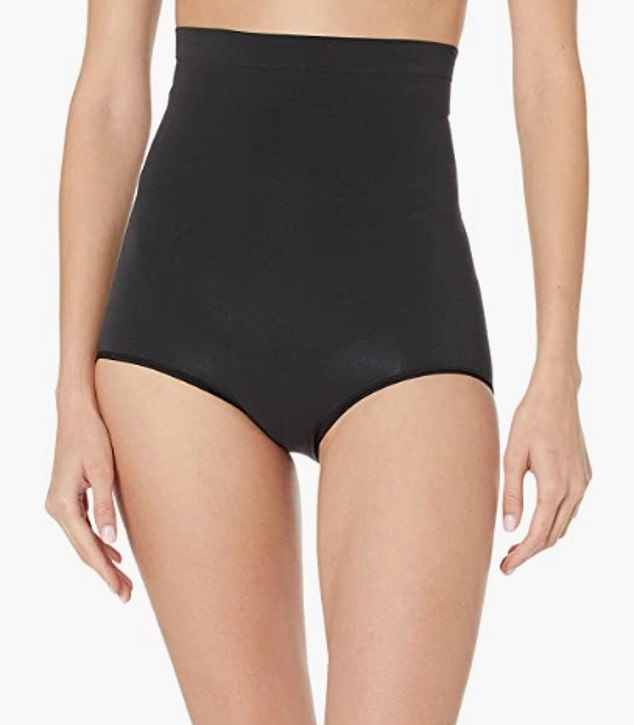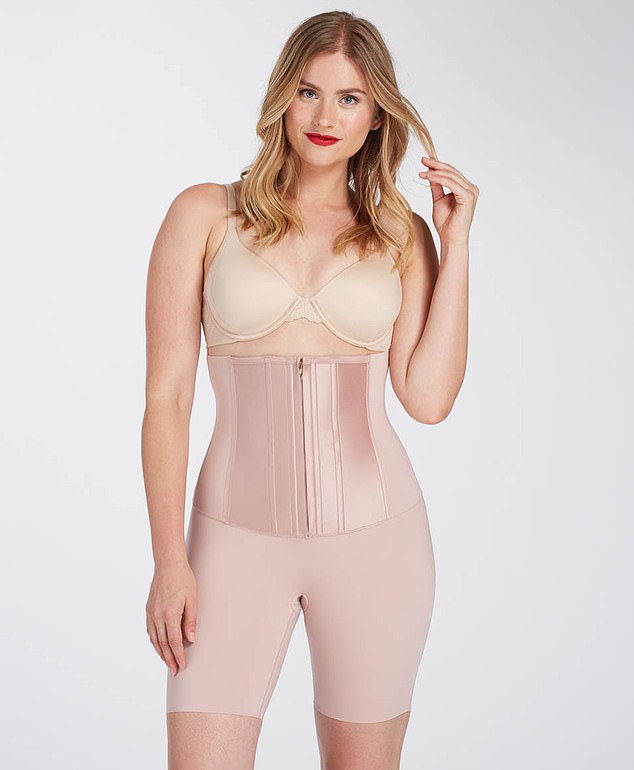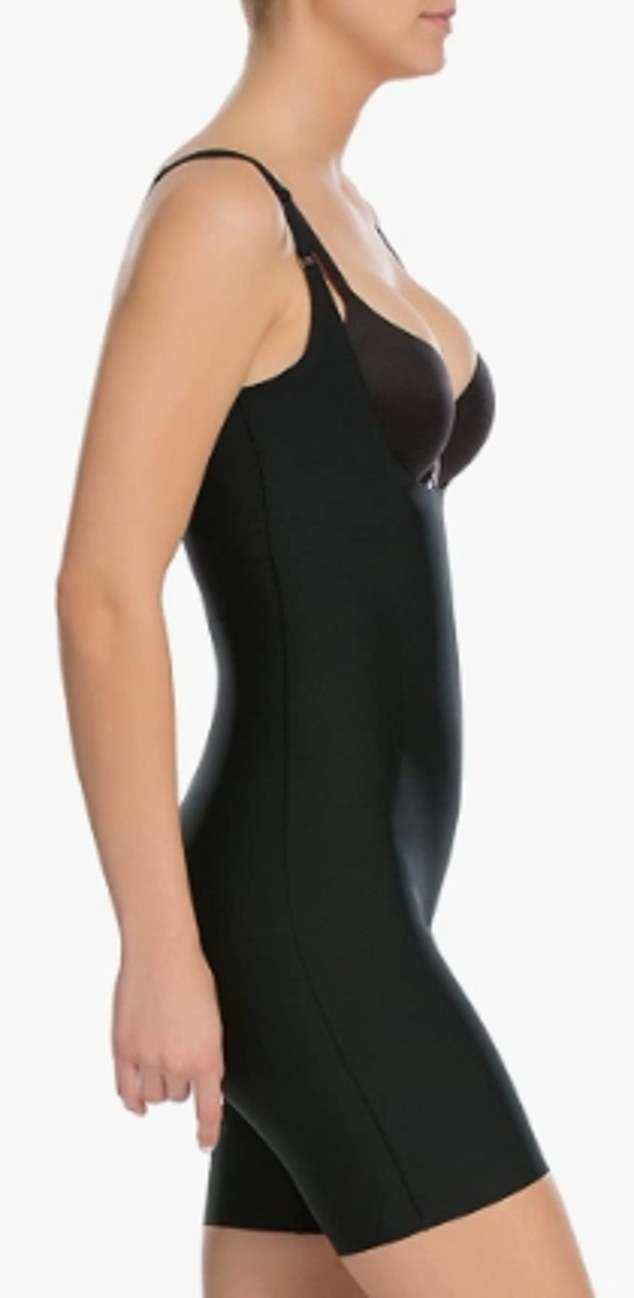From tummy-tightening control pants to butt-enhancing leggings and full-body underwear that compresses thighs and arms, shapewear is booming in popularity.
Global sales are forecast to reach almost £3 billion in 2025, up from almost £2 billion in 2019.
While most people (43 percent) want their waist to look slimmer, others (17 percent) want to slim their overall figure and 11 percent want to smooth out their hips, according to a survey by fashion company Kaleidoscope.
But could we have to pay a price for our health?
Experts warn that these garments can sometimes cause various health problems, such as urinary tract infections, skin problems and even heartburn.
The idea of using underwear to enhance a woman’s silhouette is, of course, nothing new: for centuries, women achieved narrow waists by wearing corsets and some found that their health suffered as a result.
Innovative fabrics make shapewear more breathable, but modern garments can still cause health problems
According to a review of studies published in The Classic Journal in Spring 2024, which examined the effects of Victorian corset use, women commonly suffered from deformed ribs and a condition called “chicken breast,” where the ribs were so compressed that they weakened to the point of collapse.
The advent of materials such as Lycra, Spandex and other innovative fabrics to make shapewear more breathable and mobile has meant that most shapewear no longer carries such serious risks, but that doesn’t mean modern garments can’t still cause problems, says Dr Shirin Lakhani, a GP and intimate health expert based in Kent.
“Wearing shapewear occasionally shouldn’t have any negative impact on your health; it’s when you wear it every day for most of the day that it can cause problems,” she says.
‘It is those designed to contain the abdomen and thighs that are too tight and constrictive that are particularly problematic.
‘That’s partly because they increase moisture in the genital area, putting you at risk for urinary tract infections (since trapped moisture can encourage bacterial growth) or fungal infections, such as thrush.’
The biggest risk, she says, is for women going through perimenopause (the years leading up to menopause), as this is when the vaginal wall thins due to a decline in estrogen levels, making it easier for bacterial and fungal infections to take hold.
Dr Sarah Jenkins, a London-based GP specialising in women’s health, adds: “Women aged 40 or over, who are in perimenopause and whose microbiome (the microbes – bacteria, fungi, viruses – that live in and on our bodies) is changing may be more susceptible to these intimate health issues.”

Compression garments that squeeze the abdomen can affect breathing
She says lower levels of beneficial lactobacillus in the vaginal microbiome at this time of life may allow harmful bacteria to take hold.
‘There needs to be good air circulation and for the skin to breathe. Girdles cause more chafing and sweating in that area, as well as infections, which makes “bad” bacteria and Candida infection (which causes thrush) proliferate in moist areas.’
Plus, there’s a practical problem, says Dr. Lakhani: “Shapewear is uncomfortable to put on and take off, so if you wear tight compression clothing you won’t go to the bathroom as much as you should, and that will also increase your risk of UTIs.”
This is because delaying visits to the bathroom can allow bladder bacteria to multiply and thrive.
It’s one of the reasons Dr. Lakhani warns that shapewear should be reserved for special occasions only and not for everyday wear.
And yet there are other risks associated with its use, he says.
For example, she warns that overly tight garments can put pressure on the intestines, stomach and colon, potentially worsening digestive problems such as bloating, acid reflux and heartburn (when stomach acid leaks up the esophagus, causing a burning sensation).
Dr. Jenkins adds, “If you have acid reflux and wear compression pants (to shape your waist or hold in your stomach), the extra pressure on your abdomen can cause more acid to rise.”
What’s more, this increased abdominal pressure may increase the risk of incontinence, says Dr. Lakhani.
‘As the pressure in the abdomen increases above the pressure of the urethral sphincter (the muscle that controls the flow of urine), that’s when we have losses.’

“Anything that restricts blood flow around the body will cause problems” – if a garment is too tight, it can cut off circulation.
It can even contribute to pelvic organ prolapse (when the pelvic organs drop due to damage to the surrounding muscles and tissues).
“The effect of tight girdles is comparable to that of being overweight or pregnant: the increased pressure on the abdomen can put pressure on the organs and force them to move down and out,” says Dr. Lakhani.
Most shapewear is made of nylon, spandex or microfiber, which, especially in the summer, can cause rashes.
Dr Lakhani explains: ‘Synthetic material is stretchy, but is more likely to cause rashes because it is not as breathable as cotton.
‘Tightness, heat and humidity can cause chafing and irritation.
‘And hives (itchy bumps caused by an allergic reaction) can be a problem if you’re allergic to one of the components of the material.’
One way to avoid these problems is to look for shorts, briefs or bodysuits with a cotton gusset, Dr. Jenkins advises.
Any compression garment that squeezes the abdomen can also have an adverse effect on our breathing.
Dr. Lakhani explains: “Binders that are too tight can restrict the movement of the rib cage. The rib cage moves outward and upward, and the diaphragm moves downward when we breathe.
‘In Victorian times, when women wore corsets with no flexibility, they fainted from not being able to breathe deeply enough.’
Dr Jenkins adds: ‘But if your shapewear is causing you symptoms like not being able to breathe properly, you need to ask yourself: why are you doing that to yourself?
‘You want the shapewear to target your subcutaneous fat and skin layer, not crush your internal organs.
“Also, if you use it every day and as a result you don’t move properly, or it affects your posture, then it could have a domino effect on your muscles.”
Basically, it could make them weaker and less able to attract you naturally.
Meanwhile, tight-fitting leggings and sports bras (which are a far cry from girdles that are meant to be tight enough to alter the appearance of the body) can still be problematic, even though they are designed to allow full movement.
As Dr. Lakhani explains, anything too tight could inhibit blood flow.
“Wearing clothing that is too tight around the abdomen can reduce blood flow to the legs, which can worsen varicose veins, for example,” she says.
“Blood circulates throughout the body, so anything that restricts that flow can cause problems. If a garment is too tight, it will cut off circulation to those areas.”
Signs that your shapewear is too tight include skin discoloration, pain when walking, or numbness or tingling. If you experience any of these symptoms, you should remove the garment and purchase a larger size.
There is no evidence that shapewear can actually permanently reshape our bodies or make us slimmer, so don’t be tempted to opt for a tighter garment.
Finally, and perhaps surprisingly, wearing shapewear can have a negative effect on our mental health.
A survey of 2,000 men and women by Opinium last year found that 45 per cent of users said it has a negative impact on their body image, making them less confident in the long term, and 83 per cent of women who bought shapewear reported feeling less confident about how their body looked when not wearing it.
Maybe the solution is to learn to love our bodies more and let the flabby parts hang freely.

